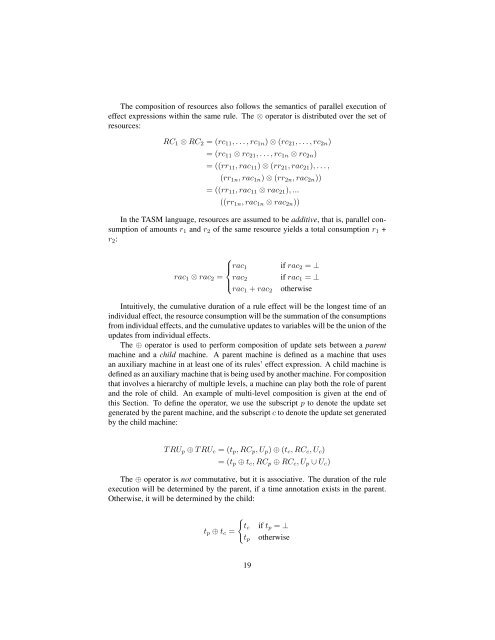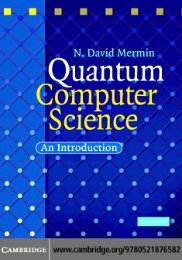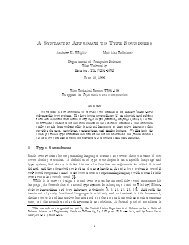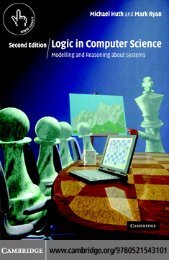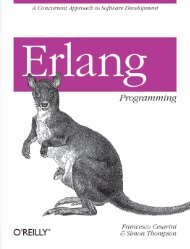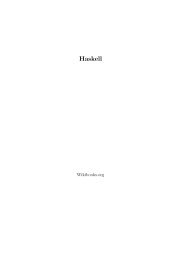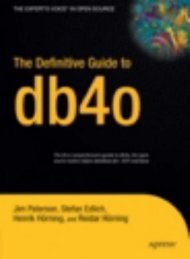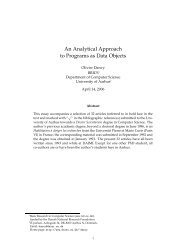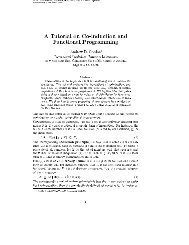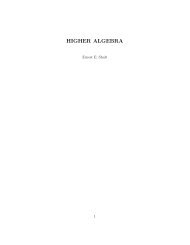The TASM Language Reference Manual Version 1.1 - Synrc
The TASM Language Reference Manual Version 1.1 - Synrc
The TASM Language Reference Manual Version 1.1 - Synrc
Create successful ePaper yourself
Turn your PDF publications into a flip-book with our unique Google optimized e-Paper software.
<strong>The</strong> composition of resources also follows the semantics of parallel execution of<br />
effect expressions within the same rule. <strong>The</strong> ⊗ operator is distributed over the set of<br />
resources:<br />
RC 1 ⊗ RC 2 = (rc 11 , . . . , rc 1n ) ⊗ (rc 21 , . . . , rc 2n )<br />
= (rc 11 ⊗ rc 21 , . . . , rc 1n ⊗ rc 2n )<br />
= ((rr 11 , rac 11 ) ⊗ (rr 21 , rac 21 ), . . . ,<br />
(rr 1n , rac 1n ) ⊗ (rr 2n , rac 2n ))<br />
= ((rr 11 , rac 11 ⊗ rac 21 ), ...<br />
((rr 1n , rac 1n ⊗ rac 2n ))<br />
In the <strong>TASM</strong> language, resources are assumed to be additive, that is, parallel consumption<br />
of amounts r 1 and r 2 of the same resource yields a total consumption r 1 +<br />
r 2 :<br />
⎧<br />
⎪⎨ rac 1<br />
rac 1 ⊗ rac 2 = rac 2<br />
⎪⎩<br />
rac 1 + rac 2<br />
if rac 2 = ⊥<br />
if rac 1 = ⊥<br />
otherwise<br />
Intuitively, the cumulative duration of a rule effect will be the longest time of an<br />
individual effect, the resource consumption will be the summation of the consumptions<br />
from individual effects, and the cumulative updates to variables will be the union of the<br />
updates from individual effects.<br />
<strong>The</strong> ⊕ operator is used to perform composition of update sets between a parent<br />
machine and a child machine. A parent machine is defined as a machine that uses<br />
an auxiliary machine in at least one of its rules’ effect expression. A child machine is<br />
defined as an auxiliary machine that is being used by another machine. For composition<br />
that involves a hierarchy of multiple levels, a machine can play both the role of parent<br />
and the role of child. An example of multi-level composition is given at the end of<br />
this Section. To define the operator, we use the subscript p to denote the update set<br />
generated by the parent machine, and the subscript c to denote the update set generated<br />
by the child machine:<br />
T RU p ⊕ T RU c = (t p , RC p , U p ) ⊕ (t c , RC c , U c )<br />
= (t p ⊕ t c , RC p ⊕ RC c , U p ∪ U c )<br />
<strong>The</strong> ⊕ operator is not commutative, but it is associative. <strong>The</strong> duration of the rule<br />
execution will be determined by the parent, if a time annotation exists in the parent.<br />
Otherwise, it will be determined by the child:<br />
t p ⊕ t c =<br />
{<br />
t c<br />
t p<br />
if t p = ⊥<br />
otherwise<br />
19


